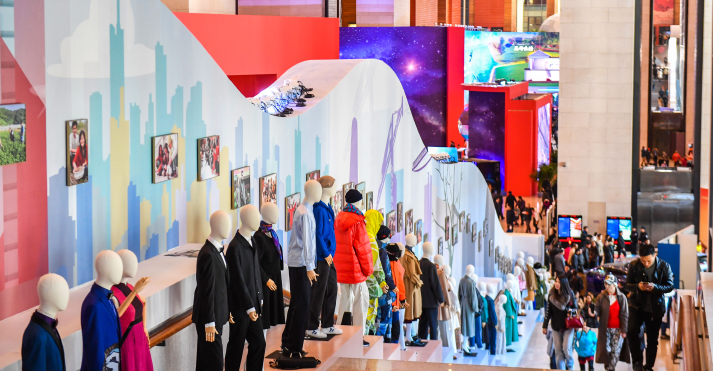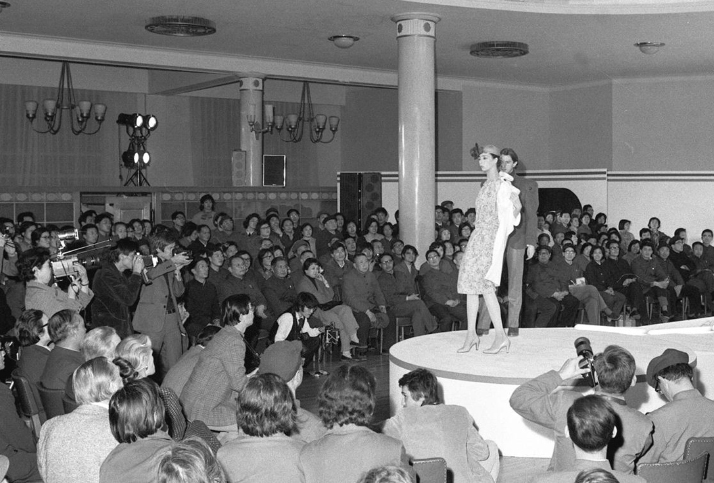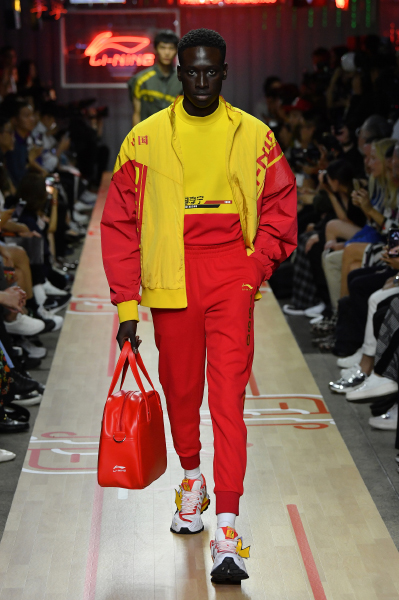| People’s Livelihood |
| Fashion Swings | |
| Chinese brands emerge, grow and go global | |
|
|
 Popular clothes in the past 40 years on display at an exhibition commemorating the 40th anniversary of reform and opening up at the National Museum of China in Beijing (XINHUA)
Sun Youting, one of the first fashion models in China, still gets excited when recalling how her fate changed in 1979. She was stopped on a Beijing street by a man who asked her whether she wanted to be a model. "I had never heard the word before and asked what it was," Sun said. After learning that it entailed "wearing pretty clothes and walking on stage," she immediately said yes. But this decision was met with strong opposition from her family since no one considered it a serious job. "I didn't have a clue as to how it worked, but wearing pretty clothes was definitely the strongest attraction for me," Sun said, recounting that she stuck to her decision and quit her job as a factory worker. In those days, Chinese streets were dominated by black, dark blue, gray and army green. What made Sun stand out, she thinks, apart from her height of more than 1.7 meters, was a self-made white collar that she attached to her blouse. "Who doesn't want to wear pretty clothes?" Sun asked rhetorically. "That was all I could do to be different from others." Along with 11 other women, Sun became part of China's first model team created by Pierre Cardin, the world-renowned French fashion designer who was eager to introduce his brand in China. The country had just introduced reform and opening up in 1978, and fashion for fashion's sake was alien to most Chinese people at the time. After intensive training, the women presented the first Pierre Cardin fashion show in Beijing. The event proved to be a great success. Pierre Cardin soon became a household name in China.  Pierre Cardin presents the first fashion show in China after reform and opening up in Beijing in March 1979 (XINHUA)
From factory to fashion It was also in 1979 that a cashmere factory was set up in Inner Mongolia Autonomous Region. It was a bold move since many Chinese in those days were not familiar with cashmere or in the habit of buying cashmere clothes. "More than 70 percent of the world's cashmere is from China, with more than half of it from Inner Mongolia. The cold and dry climate in the region produces goats with unusually soft and warm hair," Wang Linxiang, the founder of the factory, said. "But China didn't have its own cashmere brands. Foreign companies bought our material at low prices but sold them at very high prices." The factory named its brand Erdos. In 1989, they started advertising on state broadcaster China Central Television with the slogan, "Erdos cashmere warms the whole world." As a result, Erdos sales skyrocketed to the point where there was an Erdos store in just about every big shopping mall in the country. "I bought my first Erdos cashmere sweater in 1999," 58-year-old Chu Yunxia told Beijing Review. "I was so impressed by its color and design when I saw it at a shopping mall. It cost me around 900 yuan, quite expensive, as my salary was only a little over 1,000 yuan. But it is very durable and I have worn it almost every year since." Chu's daughter Gu Yan, a 21-year-old senior in college, is also a fan of Erdos products. "I didn't like the brand when I was a teenager although I was often at the store with my mother," Gu said. "The designs were quite outdated for young people, but now it is much more fashionable and has become a favorite choice for many of my friends." The brand's fashion spinoffs began after Wang Zhen, the daughter of the founder, took over the company. Spinoff brands—including 1436 for the luxury market and Blue Erdos featuring simple designs and affordable prices—were created to meet more specific consumer needs. "We want to make cashmere cool and change its image in many people's mind as a product only for middle-aged and senior people," Wang Zhen said. "It has more possibilities." Currently, Erdos is the biggest cashmere company in the world, with more than 40,000 workers and annual sales revenue of more than 40 billion yuan ($5.79 billion). Erdos' efforts to change its image are an example of how many Chinese brands have sought to revive themselves in recent years after struggling with the impact of competition from international big names. Li Ning, a sportswear brand founded by former Olympic gold medalist Li Ning in 1990, made a tremendous start when it was selected as a sponsor of the 1990 Beijing Asian Games. But due to management missteps and intensifying competition, the brand lost many years. The turnaround came in February with its well-received show at New York Fashion Week. Photos of models wearing Li Ning's new designs soon swarmed China's social media, drawing young people to the brand. "It is so Chinese and so cool," Lin Shuai, a 19-year-old Chinese posted online. "Especially the hoodie, all black with red Chinese characters spelling out 'China Li Ning' across the chest. I can't wait to buy it."  A model walks the runway during the Li Ning Spring/Summer 2019 show as part of Paris Fashion Week on June 21 (VCG)
New revival Liad Krispin, a former marketing guru at sportswear giant Adidas, has been working with Li Ning for more than a year as brand consultant. According to him, Chinese nostalgia is gaining popularity not only in China but also around the world, and China's heritage can help Chinese brands to expand their international market share in the long run. Feiyue sneakers are also a good example of rebranding. Established in Shanghai in 1959, Feiyue evokes fond memories for many in the older generations since it is one of the few sneaker brands they could afford in school. "We called it the small white shoes," said Xue Zhentang, a 36-year-old teacher in Hejin City, north China's Shanxi Province. "It was a must-have item throughout our school days because it was cheap and everybody wore them, especially for sporting events. After the sneakers got dirty, we washed them carefully to keep them as white as possible." With the impact of international brands like Adidas and Nike, the "small white shoes" were almost pushed off the stage. "When I thought it was only a memory, I was surprised recently to see more exclusive Feiyue sneakers," Xue said. "It has more fashion designs and many young customers love it." Feiyue has not only become a new fad among young people, but it has also reached foreign stars such as Orlando Bloom, who loves the brand and bought a pair for his son. "I am very happy to see the time-honored Chinese fashion brands picking up in recent years," Xue said. "My father said for his generation, they just needed the clothes to be as durable as possible since they spent most of their time either in factories or in the fields. Our generation is lucky to have more options, even though many of them are still foreign brands. I hope my child's generation can grow up with more Chinese brand choices." Copyedited by Rebeca Toledo Comments to yuanyuan@bjreview.com |
|
||||||||||||||||||||||||||||
|